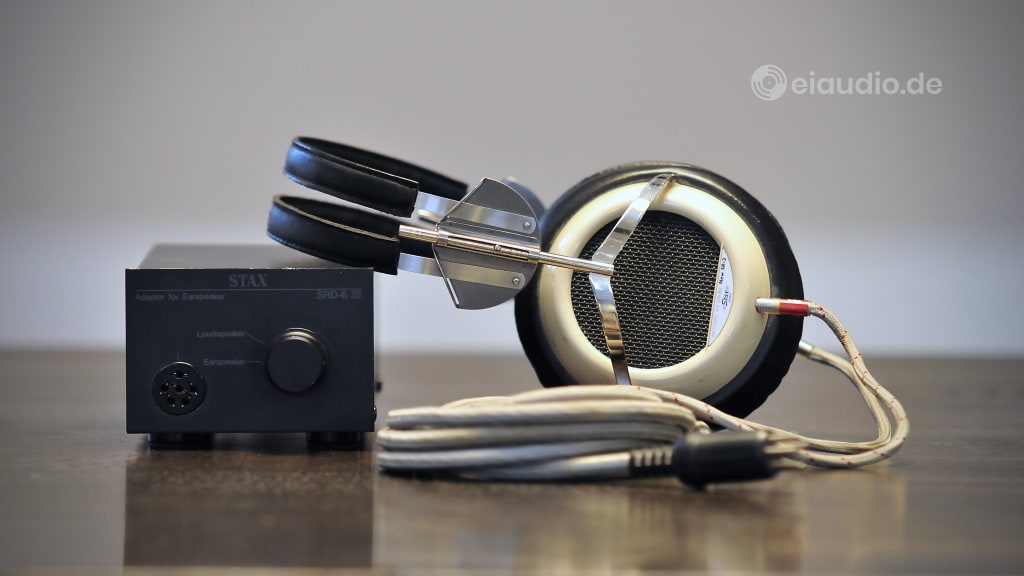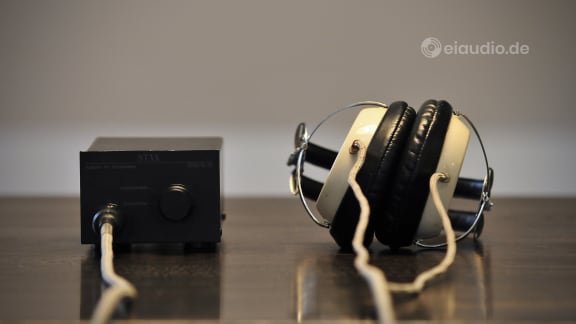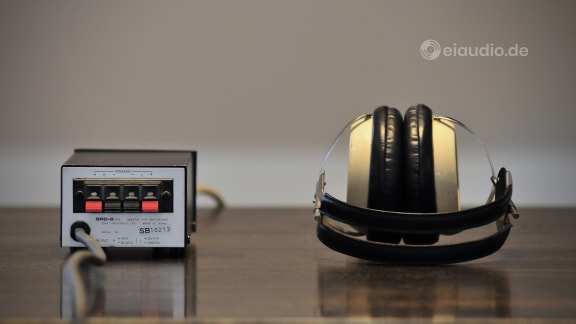Stax New SR-3
Published: 10/03/2022
Manufacturing date: 1971
Author: Karsten Hein
Category: Gear & Review
Tag(s): Headphones
It all started when Luigi received a pair of 1971 to 1975 Stax headphones and dropped them off at our office for testing. I was just finishing up an article on Jörg Hegemann‘s "High End Boogie Woogie" recording sessions at Hansahaus Studios and could see that this would take some time to complete. However, Luigi suggested that he would not need the headphones back anytime soon and insisted that I give them a try. One reason for his curiosity may have been that I had just completed a series of reviews covering more conventional headphones, and the Stax were of electrostatic design, ‘ear speakers’ as Stax had lovingly christened them.
The most far-out headphone design that I had previously tested had been HiFiMAN’s planar magnetic HE-400i. The planar design concept had often been compared with electrostatic designs, and, I guess, Luigi and I were both eager to learn what the fuss was about. I was not a novice to electrostatic technology either, having run a pair of Martin Logan SL-3 loudspeakers on our main system for a number of years. There was much to suggest that—despite their biblical age—auditioning the New SR-3 series would turn out to be an enjoyable and worthwhile experience for us.
Following my article of a Thorens TD 320 turntable, I once again found myself with some time on my hands and connected the Stax converter model SRD-6/SB to the speaker terminals of our Hafler XL280 amplifier. The way the Stax input cable was designed, it needed an amplifier that had its binding posts for both channels in close proximity to each other. Since this was not the case on our other amplifiers, the Hafler seemed a given. Our input sources were a Technics SL1310 turntable with AT VM540 ML cartridge and a Marantz CD17 CD player paired with a Cambridge DACMagic with upgraded ZeroZone power supply. All peripheral components assured that we had excellent signal quality coming to the Hafler, the latter of which was a true ultra-linear MOSFET powerhouse in its own right.
It first seemed strange to power a small set of headphones with a 145 watts RMS per channel amplifier, however, such was the preferred playing field of the electrostatic design. The two stators in the headphones needed to bridge a gap of 300 microns by means of static electricity and this could take some time and power to build up. I noticed that for the first 20-30 minutes after switching on, the Stax New SR-3 still sounded dull and lifeless, character traits that are not commonly associated with nimble foil drivers. Once fully charged, however, the sound became more agile. Initial channel imbalances were soon forgotten. It was possible, however, that a hair got caught in the stator, leading to a popping discharge of stator bias. This could make the afflicted side lose volume for a few minutes, until the full bias charge was replenished. Our electrostatic Martin Logan loudspeakers, by comparison, did not (and could not) rely on amplification alone to charge their stators and were instead connected to the power grid for stable power potential on the stators. I could see the benefit.
Being somewhat used to our AKG K712 Pro headphones, the Stax ultra-balanced sound took a moment getting used to, before their true merits started to shine through, making me wonder how I had managed not to notice them right from the start. Let me be ultra-clear on this: With the Stax we are talking serious headphones, not some half-baked Bluetooth fashion article with fancy noise cancelling that also cancelled out half the music in the process, as I had heard plenty from both Sony and JBL headphones. No, the Stax SR-3 were, like the AKG K712 Pro, serious listening tools for those who were sensitive to how their music sounds.
Despite their advanced age, the Stax SR-3 offered superb tonal accuracy that allowed the differentiation between a myriad of natural instruments and playing styles. This became especially apparent when many musicians were playing their instruments at the same time, e.g. in Classical music or more complex Jazz arrangements. Instrument separation was the best I had heard and—due to the proximity of the drivers—even surpassed that of our Martin Logan SL-3 speakers. The overall impression was a combination of immediacy and attack, with the music at times crashing out of the headphones with a vengeance. And yet, the stage remained close and intimate, definitely not as spacious as I was used to from our K712 Pros. Similar to our AKGs the Stax excelled at providing lots of high resolution and nuance. Their special strength lay in a superior sense of order at very low noise levels. Natural instruments, piano keys, and metallic sounds benefited from the SR-3’s superb tonal colours. With the stators fully charged, there was a good sense of mid-bass punch, too, which made mid-size drums really come alive.
On the downside, bass extension could have been better, especially in direct comparison with our AKG headphones. From the model I tested, I would have to disagree with Ken Rockwell that this was simply the result of their superior linearity. Some aspects of the lower bass spectrum were simply missing from the music. Bass dynamics also could have been more pronounced on my test sample. This could have been a result of the physical age of the headphones, of course. Half a century must have had an affect on the materials, even if the electronics of the drive unit had recently been serviced and restored where necessary. Another factor to be considered was the Stax’s need for lots of clean amplifier power, which needed to be available at least 30min before each listing session for the stators to be properly charged. Not many people will be able to set aside such a formidable amplifier for the purpose of powering their headphones. And, although the Stax drive unit SRD-6/SB was designed to pass the amp signal through to the main speakers, permanently placing the small black box and its outdated terminal clamps in the signal path of your everyday system would probably not be a great idea.
The Stax offered what I would describe as tonal robustness, that is to say, they produced natural tonal colours that seemed more crude, raw, and realistic than on our more pleasant and refined sounding AKG headphones. In female vocals, there could be a trace of confinement and squeakiness at times, as if the vocals were conveyed via a public address system. I listened to this effect many times over, once even falling asleep during the analysis, and, in the end, I had the impression that the compression was the result of the closed back of the ear cups reflecting back the sound. As I did not conduct any measurements, there could be a host of other reasons for this phenomenon as well. Later Stax headphones had open back ear cups that allowed the inverted outward frequencies to disperse and fade into the environment more naturally, instead of being folded back through the diaphragm. In our listening room, the Martin Logan speakers are given at least three feet distance to the front wall to sufficiently delay the reflected sound.
The New SR-3 headphones presented a wonderful opportunity for us to experience the electrostatic design first hand. For those of us who do not mind having a spare power amplifier on standby, the SR-3 deliver at least 80% of what can be expected from electrostatic headphone designs, and this at a small fraction of the usual price. One needs to consider that, after half a century, the electronics might need looking at, and one needs to be sure to audition them before making a purchase. However, without directly comparing the SR-3 with modern headphones such as the AKG 712 Pro, they offer everything it takes to find great joy in listening to music. It is only in direct comparison that our AKG’s superb design managed to show a bit more of everything, perhaps with the exception of the Stax’s raw tonal colours, a discipline in which the SR-3 are difficult to beat.
Specifications
- Diaphragm: ultra-thin, approx. 5 microns thick*
- Stator electrode gap: approx. 300 microns*
- Input: Stax standard (230 V bias) 6-pin adapter energizer
- Impedance: approx. 130,000 Ohms* @ 10,000 Hz
- Capacitance: approx. 120 pF*
- Sensitivity: 95-100 dB @ 100V RMS*
- Frequency range: approx. 30 - 25,000 Hz*
- Cord design: straight, supple cloth-covered
- Cable length: 2.5 meters, 6 mm
- Weight: 290g without cord; 373g with cord
- Drive unit: model SRD-6/SB
- Drive unit polarity: (R) +red -black / (L) +white -green
- Country of manufacture: Japan
- Year(s): 1971 - 1975
*measurements and estimates by Ken Rockwell, 2011





